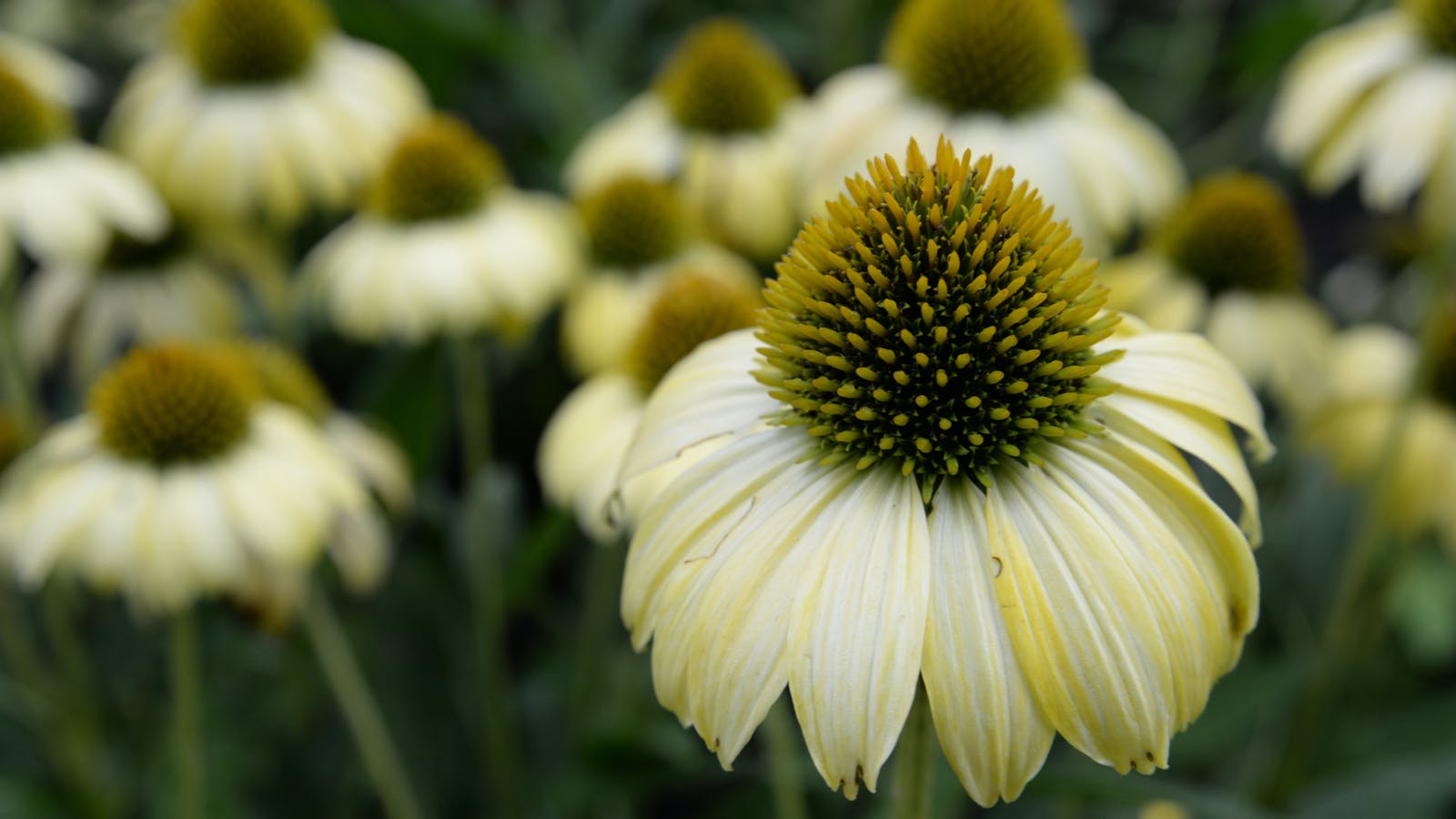Discovery
Echinacea is native to North America and includes several species with recognized benefits. Native Americans were the first to use this plant to treat various health problems, including infected wounds, snake bites and fever. When American doctors discovered the benefits of this ancestral plant , they began to sell it and prescribe it to treat lung infections. Echinacea was even included in the list of pharmaceutical ingredients in the United States National Formulary until 1950, before being forgotten and replaced by synthetic antibiotics. This plant , also discovered in 1920 by German doctors, continues to be used in German clinical practices. It was the German doctor Gerhard Madaus who undertook the first series of scientific studies on the benefits of echinacea . Following his tests, he decided to establish this plant in Europe and have it cultivated. She becomes popular there.
Botanical
Echinacea is a perennial plant which, unlike annual plants , is capable of living for several consecutive years. For most perennial plants , they lose their leaves in autumn and become invisible in winter, even if their roots remain underground. This ancestral plant used so much by Native Americans is part of the Asteraceae family. It takes its name from the ancient Greek “ekhinos” meaning “sea urchin, hedgehog”, which alludes to the thorny appearance of its center. It is a plant that is often found in rocky forests, dry meadows and on sandbanks and is grown in temperate climates, in sunny places. It measures 60 to 180 cm in height and is recognizable thanks to its purple or yellow flowers gathered in balls and its generally pink drooping flowers.
There are around ten varieties of echinacea but only three are considered medicinal and used in herbal medicine: Echinacea angustifolia , Echinacea pallida and Echinacea purpurea . They can be differentiated by the color of their flowers, more or less dark.
In therapy, depending on the species chosen and the desired effect, the aerial parts of the plant can be used, either the stem and the flower, or the roots.
Properties
Echinacea is recognized for its immunostimulating, antibacterial and antiviral properties which give it the ability to strengthen the body 's immune system and help prevent the appearance of certain infections. Studies have shown that these properties come in particular from the roots of the plant , rich in alkylamides and polysaccharides, active ingredients considered to be the most important in modulating the immune system.
The German European Commission recognizes the use of echinacea as an adjunct treatment for respiratory tract infections (colds, laryngitis, sinusitis), urinary tract infections, as well as its cutaneous use to treat ulcers and wounds that heal poorly . These indications are, on the whole, confirmed by the WHO (The World Health Organization) and ESCOP (The European Scientific Cooperative on Phytotherapy). ESCOP also recognizes the use of echinacea to prevent colds. Echinacea is also said to support the immune system.
Stimulation of the immune system
Several studies have proven that echinacea significantly stimulates the body 's natural defenses . It would support and strengthen the immune system and therefore allow the body to be more resistant and to better defend itself against attacks from viruses and bacteria in winter. By stimulating these defenses , it could be used as a preventive treatment to resist diseases of viral and bacterial origin or curatively to combat conditions such as flu, bronchitis, ear infections, etc. The antibacterial and antiviral properties of this plant make it a major asset in preventing recurrent respiratory infections, such as ENT infections. Finally, the anti-inflammatory properties of echinacea are very interesting since they allow it to reduce inflammation of the respiratory tissues caused during severe flu in particular.
Prevention and treatment of colds
Scientific studies have demonstrated the benefits of echinacea in reducing the incidence and duration of colds. It would also help to significantly reduce the intensity of cold symptoms such as sore throats, headaches, runny nose and nasal congestion. Data from certain studies suggested that these effects were partly due to the anti-inflammatory properties of the plant since it will be able to block the production of inflammatory molecules, called cytokines. It is therefore as effective in prevention as in treatment of colds, especially when it is consumed as quickly as possible after the first symptoms appear.
Reduction of urinary infections
The antibacterial properties of echinacea allow it to easily eliminate bacteria that attach to the walls of the organs of the urinary system in a natural way. Added to this are immunostimulating properties, which allow it to be an effective remedy against recurrences of urinary and vaginal infections.
Healing
Furthermore, it accelerates the healing of wounds and skin inflammations when used on the skin. In fact, it inhibits the proliferation of bacteria and stimulates the synthesis of collagen.
Dosage
Echinacea is available in several forms in pharmacies. Indeed, it is possible to use it in the form of capsule, infusion, food supplements, decoction, juice, tincture or even cream. It is often recommended to take 1 gram, one to three times a day during the treatment . For prevention, a single daily dose would be sufficient while for a therapeutic effect, three doses per day are recommended. To allow the body to rest and thus lose its tolerance, it is preferable not to consume echinacea all year round without a break. You can only take three weeks per month for example.
Each type of use of echinacea , internal or external, corresponds to different functionalities or a specific need.
External use of echinacea
The external use of echinacea helps promote wound healing, healing of wounds and inflammation of the skin. To do this, you must apply a cream, containing 15% juice from the aerial parts of echinacea , several times a day to the affected parts of the body.
Internal use of echinacea
Furthermore, its internal use makes it possible to act on conditions of the ENT sphere, the immune system and chronic urinary infections. At the first signs of a respiratory tract infection, it is recommended to consume echinacea internally.
You can use it in the form:
- infusion by boiling 1 gram of aerial part of echinacea in boiling water, and drinking one to six cups per day;
- decoction by boiling 1 gram of echinacea root in boiling water, and drinking three cups per day;
- food supplement (tablet or capsule), preferably from French organic farming, containing dry extract of root or aerial part of echinacea , and swallow 1 gram three times a day;
- tincture, taking 3 to 4 ml, maximum three times a day (for better assimilation, keep the extract in the mouth for a few seconds);
- of fresh or stabilized juice formulated from the aerial parts of the plant , and drink 1 to 3 ml, three times a day.
You must still pay attention to the concentration of the products which vary depending on the form used. Some are more concentrated than others and therefore more powerful. If you need additional information or have any doubts, contact your doctor. It is in all cases strongly recommended to seek advice from your doctor or pharmacist before using echinacea , to choose the form and dosage suited to your needs.
Precautions for use
The European Commission and ESCOP recommend not taking echinacea for more than 8 weeks. Indeed, if we stimulate the immune system for a prolonged period, it could either become exhausted, due to overstimulation of its defenses , or become tolerant to this stimulation, the body getting used to the effect of the plant and requiring a larger dose to maintain the same effectiveness. Its long-term effectiveness could actually decrease due to overdose.
Additionally, people with asthma or allergies are more likely than others to be allergic to echinacea . It is also contraindicated in people allergic to the Asteraceae family, who are likely to suffer from an allergy to echinacea .
A six-year-old child or those prone to recurrent ear infections should also not turn to echinacea- based products, particularly in the event of a respiratory tract infection as the plant could increase the risk.
The WHO recommends avoiding echinacea for people with autoimmune pathologies (multiple sclerosis, collagenosis, rheumatoid arthritis, etc.) or on immunosuppressants without medical advice, because of the possible effect of the plant on the immune system.
Furthermore, even if the European Commission considers that taking echinacea for pregnant or breastfeeding women is safe, some researchers recommend avoiding it because there is not yet enough toxicological data today.

